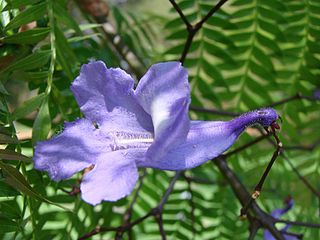
Jacaranda is a genus of 49 species of flowering plants in the family Bignoniaceae, native to tropical and subtropical regions of Latin America and the Caribbean.

Disocactus is a genus of epiphytic cacti in the tribe Hylocereeae found in Central America, the Caribbean and northern South America. It should not be confused with Discocactus, which is a different genus.

Coccocypselum is a genus of flowering plants in the family Rubiaceae. It is native to Mexico, Central America, the West Indies and South America. All species of the genus Coccocypselum are herbaceous with fleshy, blue or purple fruits, and 4-petaled flowers.
Remijia is a genus of flowering plants in the family Rubiaceae. Within the family, it is a member of the subfamily Cinchonoideae and the tribe Cinchoneae.

Llanganates National Park is a protected area in Ecuador situated in the Cotopaxi Province, Napo Province, Pastaza Province and Tungurahua Province. Located within the park is Cerro Hermoso, a 4570 meter high peak that is a popular hiking destination. The park is famous for the Treasure of the Llanganatis.

Duroia is a genus of flowering plants in the family Rubiaceae. The genus is found from Costa Rica to tropical South America.

Alibertia is a genus of flowering plants in the family Rubiaceae. It is found in tropical America. They are dioecious trees or shrubs, with white flowers and indehiscent, often fleshy fruit.
Bathysa is a genus of flowering plants in the family Rubiaceae. It was described by Carl Borivoj Presl in 1845. The genus is found from Venezuela south to Brazil and Bolivia.

Hamelieae is a tribe of flowering plants in the family Rubiaceae and contains about 171 species in 6 genera. Its representatives are found in tropical and subtropical America. The sister tribe Hillieae is sometimes here included.

Chomelia is a genus of flowering plants in the family Rubiaceae. It is native to Mexico, Central America, the West Indies, and much of South America as far south as Argentina.

Deppea is a genus of flowering plants in the family Rubiaceae. The genus is found in Mexico, Central America and from Brazil to northeastern Argentina.

Coussarea is a genus of flowering plants in the family Rubiaceae. The genus is found from southern Mexico to tropical America.

Spermacoceae is a tribe of flowering plants in the family Rubiaceae and contains about 1346 species in 57 genera. Its representatives are found in the tropics and subtropics.
Bocagea is a genus of plants in the family Annonaceae. It comprises four species distributed in Brazil. Augustin Saint-Hilaire the French botanist who first formally described the genus named it after Josephi Mariae de Souza du Bocage, who he said beautifully translated a poem about flowers into Portuguese and illustrated it.
Discospermum philippinensis is an endemic species of genus Discospermum, which are flowering plants in the family Rubiaceae. The species was described in 2015, and was found on Mt. Banahaw, Tayabas, Quezon Province, Philippines at an elevation of 623 m. This species closely resemble that of D. whitfordii because of its persistent calyx, and prominent disk below the fruit apex. However, the species differs from D. whitfordii due to leaf blades with a much larger dimensions, the leaf apex of which are acute to attenuate, the fruits of which are faintly ribbed, with the thin mesocarp that are smaller, and fewer seeds per locule.
Sphinctanthus is a genus of flowering plants in the family Rubiaceae, native to tropical South America. It is in a clade with Rosenbergiodendron and Tocoyena.











